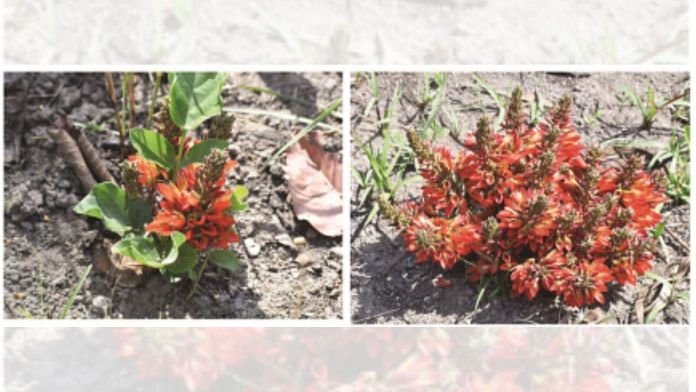New Delhi: A plant species in the Terai region of Uttar Pradesh is a real-life phoenix—it rises from the ashes of forest fires. Erythrina resupinata, a flowering plant that is usually found in grasslands, has a unique life cycle that revolves around the forest fire season in the Terai region, a lowland area situated along the foothills of the Himalayas, and characterised by tall grasslands. After forest fires burn all vegetation to a crisp in the forests, small scarlet flowers of E. resupinata bloom from the ashes.
“You might think forest fires destroy all plants but this is a unique plant that needs fire to bloom and grow,” Dr Praveen Kumar Verma, a scientist at Forest Research Institute, Dehradun, whose team found the plant blooming in the Pilibhit Tiger Reserve in Uttar Pradesh during their field visits in April 2023, told ThePrint. “It shows that fires are not always destructive, and are important to certain regions.”
The study, describing the findings, was published Tuesday in the journal Current Science.
E. resupinata was originally discovered by Indian botanist William Roxburgh in the early 1800s. Despite it being discovered a long time ago, little is known about the plant. Verma’s team spotting E. resupinata in April 2023 is one of the plant’s first sightings in Pilibhit. It has been spotted only in 16 regions around the world.
A reason the plant is rarely spotted is that it is an endangered species. Its story exemplifies the intricacies of natural ecosystems and how different species interact to maintain them.
The grasslands in the Terai region of Uttar Pradesh and Nepal are prone to fires after the winter season wanes. Around 99 percent of fires in the Terai region—both manmade and natural—occur between January and May as the dry vegetation burns, clearing the way for new growth. The topography of grasslands is such that fires are necessary for the environment. Fires eliminate some plants and give birth to new ones.
E. resupinata is one such plant that has adapted to almost 4 million years of forest fires in savannas and gets its life from the flames.
“When fires occur in grasslands, most plants die. In August, the monsoon brings plants back. So how will other living beings survive without plants until then? This is when plants like E. resupinata bloom, providing pollinators and small insects with food when other grasses are missing,” Verma explained.
The plant has very thick and well-developed root systems, which help it survive the fire. When forest fires occur, the stem burns away but the roots remain. After the fire, young stems and red flowers resprout from the roots.
Verma added that fire-resistant plants similar to E. resupinata abound in the savannas of Africa and South America—Callitris intratropica, Crossopteryx febrifuga, and Piliostigma thonningii are some examples. While scientists have studied, for years, the characteristics of plants that help them withstand forest fires, very little research has been conducted in the Terai region on fire-resilient plants.
Also Read: Posture panic hits researchers. IITs, AIIMS, big hospitals use smart microscopes now
Life cycle of the plant
While conducting fieldwork in April 2023, Verma’s team came across a bright red flower that they initially thought was a stray twig from a common Erythrina plant. This genus is known for its orange-red flowers, and the researchers did not think much of the plant until closer inspection.
“We realised that it is actually a small plant called Erythrina resupinata,” said Verma. “There is very little known about it, very few pictures in historical records, and barely any mentions in historical records.”
Verma then recalled A Forest Flora of Pilibhit, Oudh, Gorakhpur, and Bundelkhand, a 1933 book by botanist P.C. Kanjilal with brief mentions of the plant. It was from this book that he got his initial understanding of E. resupinata’s features. It is a small shrub, barely two to three feet in height at its most mature stage and hence, is at a disadvantage during the monsoon season when other plants in the Terai region grow.
“Being short, it receives very little sunlight, and is covered by tall grasses in the Terai region during monsoon and winters. Hence, it does not grow during that period and is almost at a dormant stage,” explained Verma. “But once winter wanes and fires clear away the dead grasses, E. resupinata is at its peak.”
It is almost as if the fire breathes new life into the plant. In the Terai region, especially in the Pilibhit Tiger Reserve, the forest department controls firing to clear some of the dead vegetation away in February and March. Once the fires have settled, E. resupinata starts blooming flowers, after which its leaves appear, followed by fruits. Within two months—by June—the plant’s entire life cycle ends, and it goes back to a dormant state as the monsoon descends.
“It is a prime example of a plant that has adapted to forest fires—and is unique to its habitat. If the habitat dies, the plant dies too,” warns Verma. “There is no better reason to protect our diverse ecosystems, now more than ever.”
(Edited by Radifah Kabir)
Also Read: Search for an Indian Carl Sagan is on. Science influencers are being trained in labs and likes






